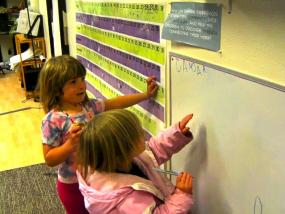Lauren Builds Letters with Marks

The two children in this video are working together to write the date on the meeting board. Harriet, in the tie-dye shirt, is dictating the letters of the word, “January” to Lauren, in the pink coat. Harriet points to and calls out each letter in the sequence: J-A-N-U-A-R-Y. Lauren writes each letter as called. She accepts some looseness in her “U” that looks more like an “O.” But her “Y" gives her pause. She tries a couple of times to rewrite it, stating, “That’s not a ‘Y’. I drawed a ‘4’ for a ‘Y’ (perhaps suggested by her teacher asking at time code 00:26, “And then what number?").” Her difficulty reminds us that building the correct form of a letter has its own obstacles. If she lays down the first line more vertically than diagonally (upper right to lower left), the next mark makes (in her words) a "4." Making a diagonal in an open field is notoriously difficult for young children (see David R. Olson, The Child's Acquisition of Diagonality, 1996). She tries again, then exclaims, " Aaahh, a ‘V’ for a ‘Y’.” She can recognize the product but has difficulty producing a readable "Y”. The difficultly comes from how she begins. She retraces the vertical spine of her "4," marking all the way to the bottom as before 00:44, then she changes directions moving upward in a diagonal. The angle of the right side is correct but the location is wrong. The salience of this vertical spine dominates her movement such that she marks to the bottom instead of stopping half way down. For young children, an action begun often must be completed to some perceptual anchor (the end of the spine). It is interesting that in spite of these misguided executions her eyes still recognize the mismatch to her mental image. Again she tries; again she retraces the original vertical spine, this time lifting her marker to begin the right branch half way up the spine. But her mark is too much at a right angle to the spine, and she exclaims once again, "Aggg, a 4." Right angles are so over-learned that they often compete with the requirement to draw diagonals. Such is the nature of printing. Recognition precedes production. Her final solution in a way is brilliant (00:63). She retraces the mark on the right side that has the correct angle but the wrong location (at the bottom) and the other mark that has the incorrect angle but the correct location (half way up the spine). At this point she accepts her symbol and is ready to move on. Her recognition does have some mismatches here and there. After feeling satisfied about the “Y,” Lauren moves on to writing the numbers. Harriet looks at the date on the calendar, but Lauren refers to the year ("a 2 and an 0, a 3 and a 1," transposing the 1 and the 3). Harriet accepts this set of numbers, dictating the numbers, “2, 0, 1, 3.” Lauren writes a “5” when Harriet had asked for a “2”. Harriet calls attention to the way the “2” looks like a “5”. Lauren goes to the calendar, recognizes a “2” and calls out the shape of its curves (01:36, "It's a hoop, and a zoop, see that's a ‘2’,” pointing to her "5"). Young readers sometimes do not distinguish a letter and its vertical reversal. (You will see this tendency again when Lauren makes a backwards “3”). For some reason Lauren wants additional confirmation and says, "I want to see a real ‘5’." One would think, yes, the comparison of the printed “5” and “2” should help her reject her own backward “2”. She does say upon seeing the “5” on the calendar, "That's not a ‘2’." But she does not correct her own printing. She also does not correct her backward “3” (02:07) after drawing a correct “3” as part of making a capital “B”. Why not? For one, her original backward “3” was not completely erased, seducing her to retrace it instead of starting fresh. But even so, the number “3” must be drawn without the perceptual anchor of the vertical line contained in the letter “B”. Once again, we see that graphic decision that has to be made is an open field that requires higher-level strategies for how to begin. This video analysis focuses on how Lauren builds her letters with marks. One could also look at the video in terms of the level of collaboration between Harriet and Lauren, the role of the teacher, or the level of the children's understanding of the concept, "today's date." In regards to "today's date," we are not sure. There was one moment (01:11) when Harriet goes to the number 16 on the calendar for the day's date (January 16) instead of the 2013 printed under the word "January." Her lack of commitment to the day's date to be written before the year's date most likely indicates that the numbers are not known by their appropriate calendar categories. Nevertheless, the children may still understand that the little squares represent time in sequence left to right and by rows, time in sequence from top to bottom. Beyond that we have to observe again on another day. Length of video: 3 minutes 16 seconds Keywords: Fours, Child-Child, Letters, Literacy, Writing, Numbers, Collaboration
